Seisdon, Staffordshire
Up to 1834
Three houses in Swan Lane (now Vicarage Drive) were leased to the parish in 1739 for 21 years and converted into a workhouse. By 1839 the workhouse was at the foot of Church Hill, adjoining the house now known as Clifford Cottage.
A parliamentary report of 1777 recorded parish workhouses in operation at Tettenhall (then referred to as 'Tattenhall') for up to 20 inmates, and at Pattingham for 10 inmates.
The Tettenhall workhouse was built in around 1715 at the south side of the junction of Redhouse Road and Wrottesley Road. It was later converted into cottages but no longer survives.
The Penn parish workhouse stood at the corner of Church Hill and Wakeley Hill, perhaps occupying one of the old cottages that still stand there.
After 1834
The Seisdon Poor Law Union formally came into being on 17th October 1836. Its operation was overseen by an elected Board of Guardians, 19 in number, representing its 12 constituent parishes as listed below (figures in brackets indicate numbers of Guardians if more than one):
County of Stafford:
Bobbington, Codsall and Oaken (2), Enville (2), Kimley, Kinfare or Kinver (2), Pattenham [Pattingham], Upper Penn, Lower Penn, Tettenhall (4), Trysull and Seisdon, Wombourn (2).
County of Salop:
Rudge.
Later Additions: Swindon (from 1896), Woodford Grange (from 1861), Wrottesley (from 1894).
The population falling within the union at the 1831 census had been 11,170 — ranging from Rudge (population 104) to Tettenhall (2,618). The average annual poor-rate expenditure for the period 1834-36 had been £3,381 or 6s.1d. per head of the population.
The new Seisdon union adopted an existing parish workhouse on Upper Green at Tettenhall which was enlarged in 1836-7. In 1851, the building could accommodate 80 although rarely had more than 50 or 60.
In 1842, the Poor Law Commissioners investigating the employment and conditions of children in mines and manufactories, discovered that workhouse boys, some as young as eight, were being sent on "apprenticeships" of up to twelve years working in coal mines. As a result, some unions in the coal-mining districts of South Staffordshire and adjacent areas were asked to provide detailed information on the children who had been apprenticed in the mining industry in recent years. Seisdon recorded only one such case: in 1841, George Barker, aged 10, had been apprenticed from the workhouse by the parish of Wombourne to the mine at Wednesfield Heath until the age of 21 with only a suit of clothes as the premium. The respondent noted that coal had once been drawn around underground workings by women and boys having a belt around their waist and a cord or belt passing between their legs. However, it was now more easily transported in small wagons pushed along on rails.
A new Seisdon Union workhouse was erected in 1858-60 to the north-east of Trysull, on the site of a monastic ruin. It was designed by George Bidlake and Lovatt and could accommodate 120 inmates. The site layout is shown on the 1903 map below.
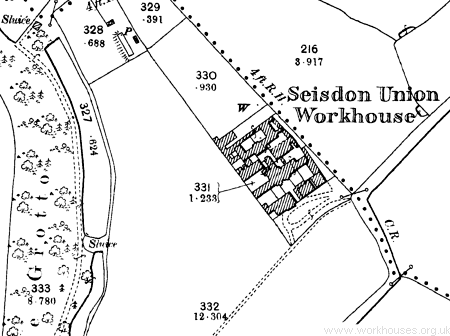
Seisdon workhouse site, 1903.
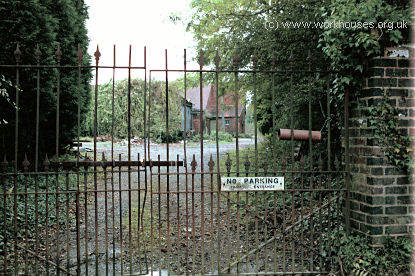
Former Seisdon site entrance from the south-east, 2000.
© Peter Higginbotham.
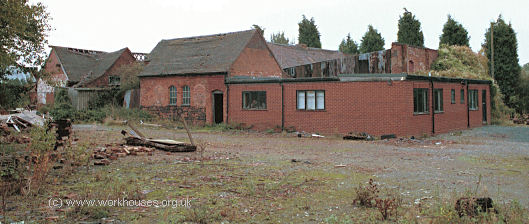
Former Seisdon workhouse site from the south-west, 2000.
© Peter Higginbotham.
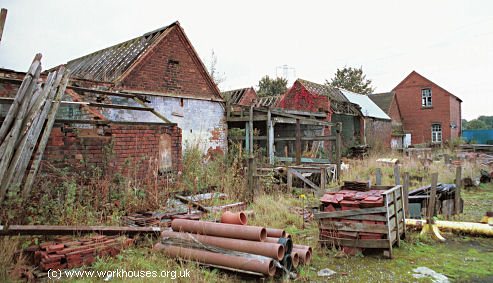
Former Seisdon workhouse site from the north-west, 2000.
© Peter Higginbotham.
After its closure in 1930, the eastern parts of the building were used as a warehouse and as an egg-packing station.
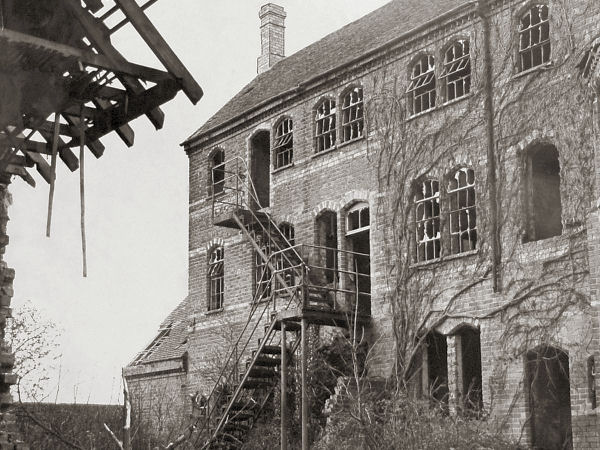
Former Seisdon workhouse, c.1957.
In 2000, a few parts of the buildings still survived but were derelict and inaccessible.
Staff
- 1851 — Master: Alex Priestley; Mastron Mrs Ann Hall; Chaplain: Rev. E.J. Wrottesley.
- 1881 Census
Inmates
Records
Note: many repositories impose a closure period of up to 100 years for records identifying individuals. Before travelling a long distance, always check that the records you want to consult will be available.
- Staffordshire Record Office, Eastgate Street, Stafford, ST16 2LZ. Holdings include: Guardians' minute books (1852-1930); Ledgers (1848-1930); Admissions and discharges (1837-1916); Indoor relief lists (1837-1930); Creed registers (1869-91); Births (1853-1914); Register of infants received (1912-29); etc.
Bibliography
- Higginbotham, Peter The Workhouse Encyclopedia (2014, The History Press)
Links
- None.
Unless otherwise indicated, this page () is copyright Peter Higginbotham. Contents may not be reproduced without permission.


